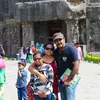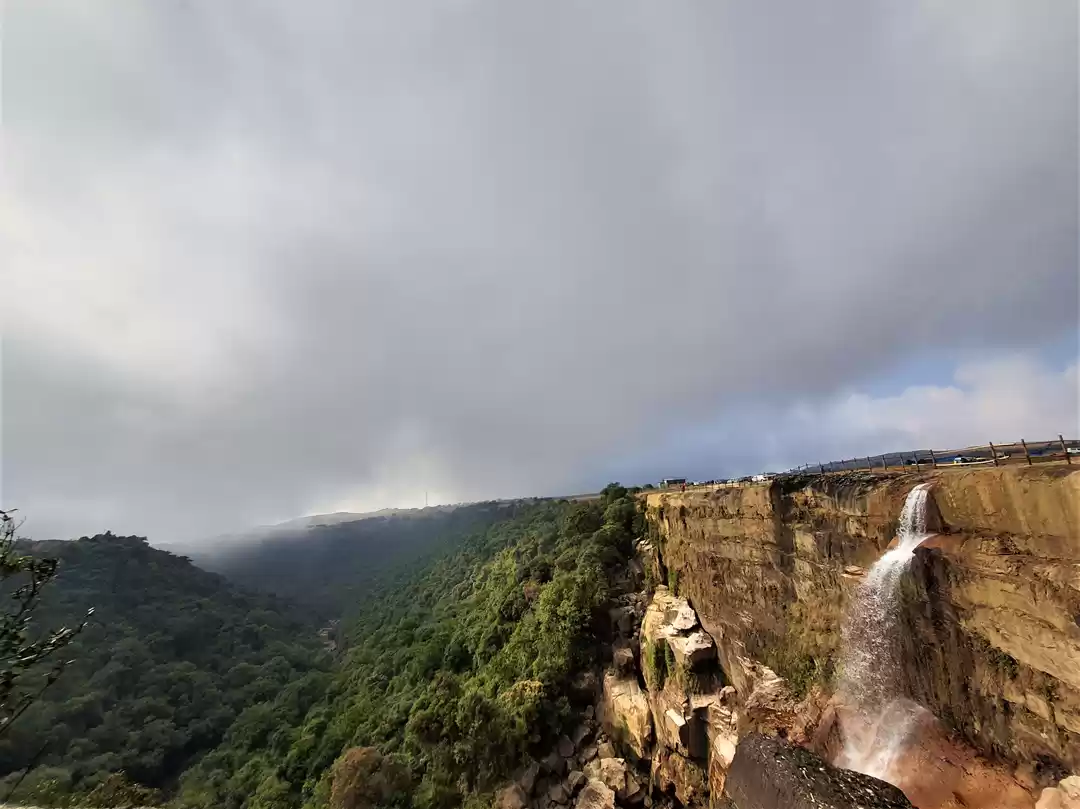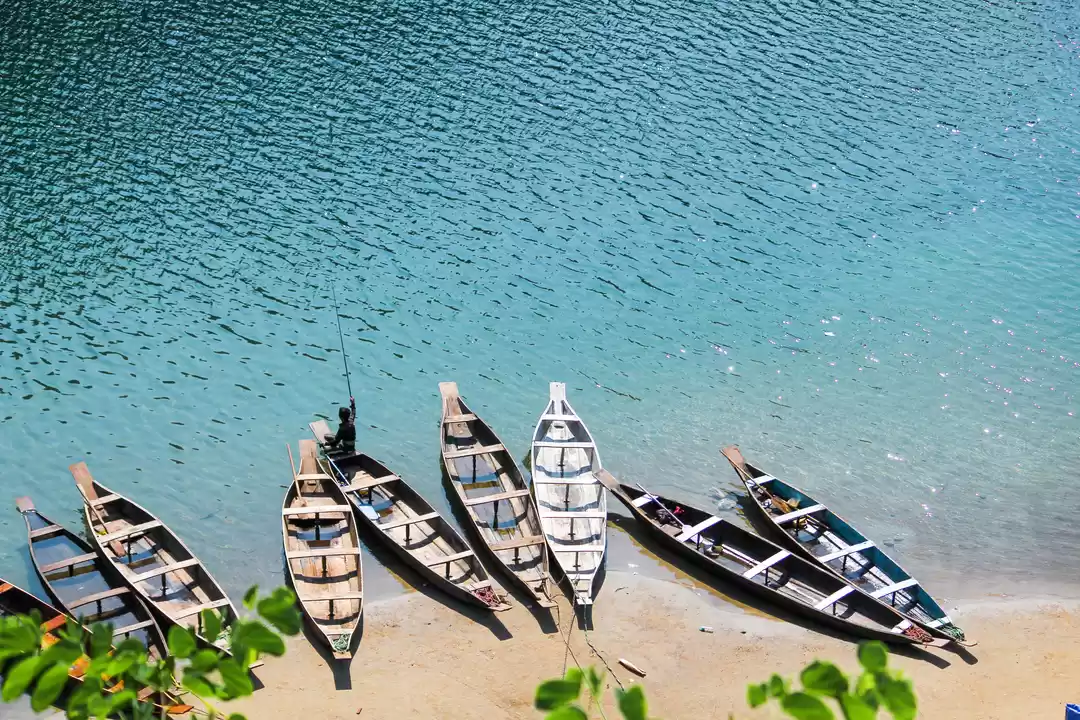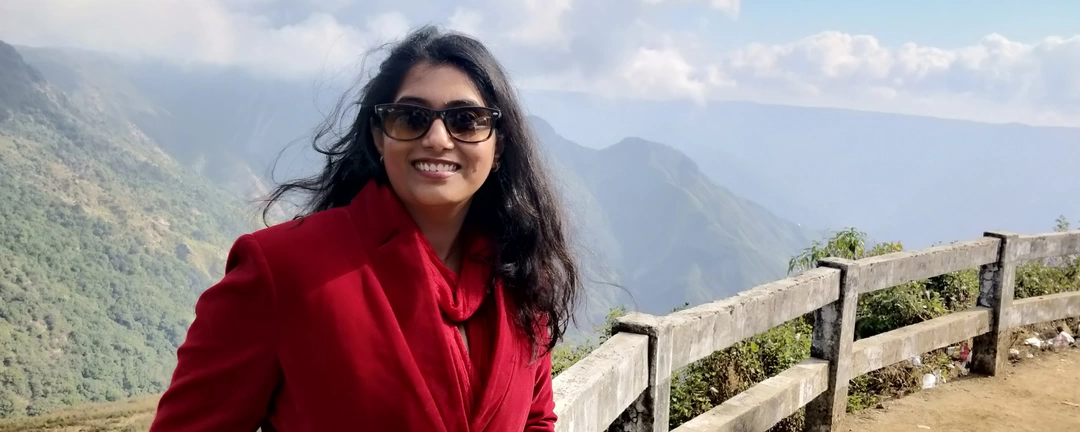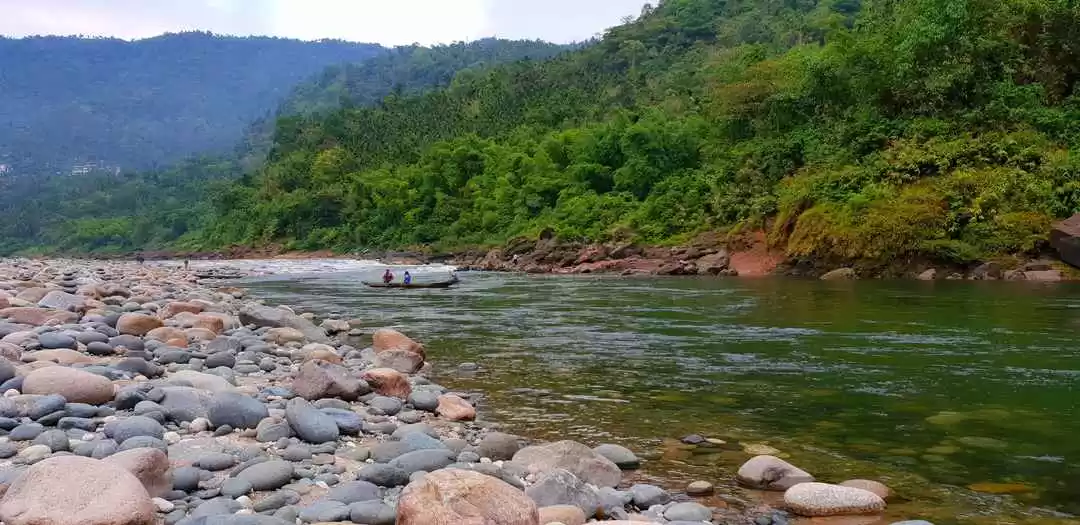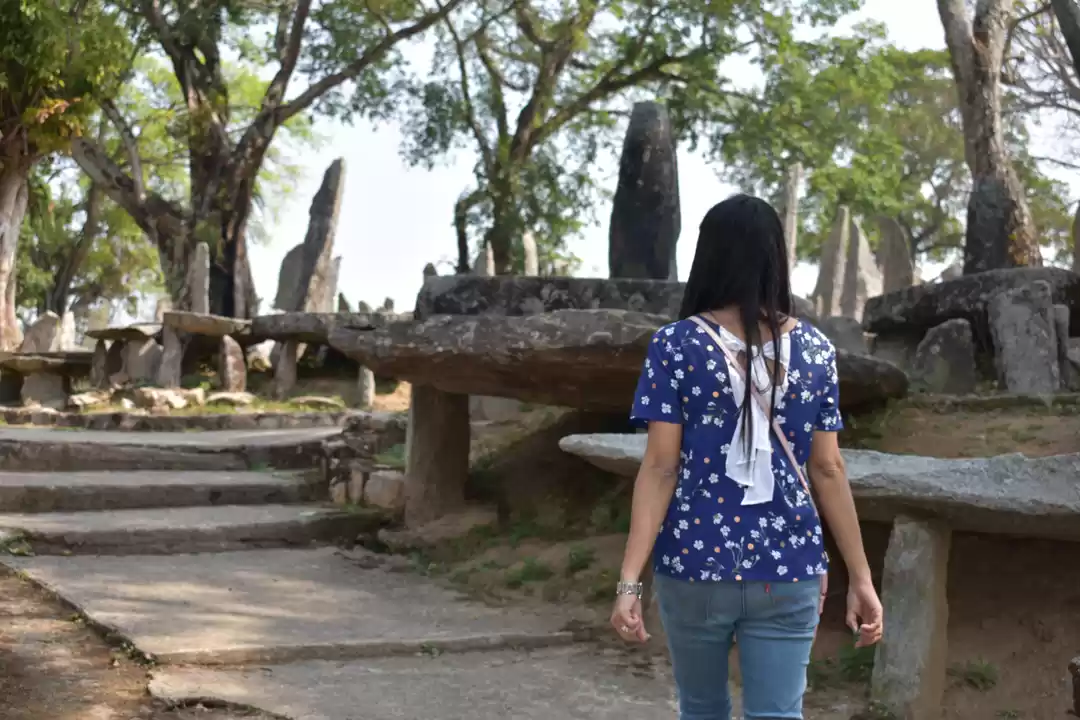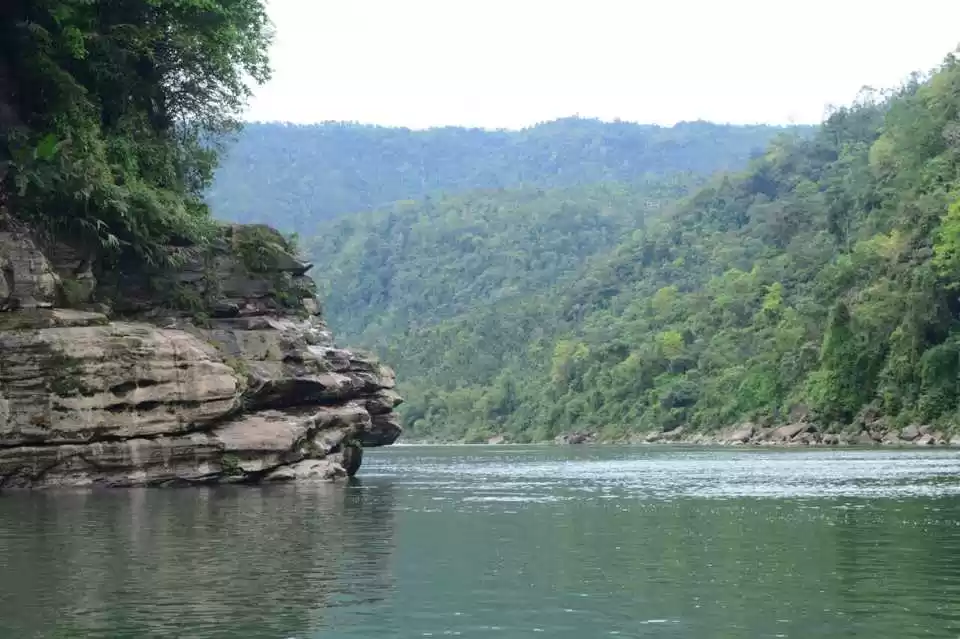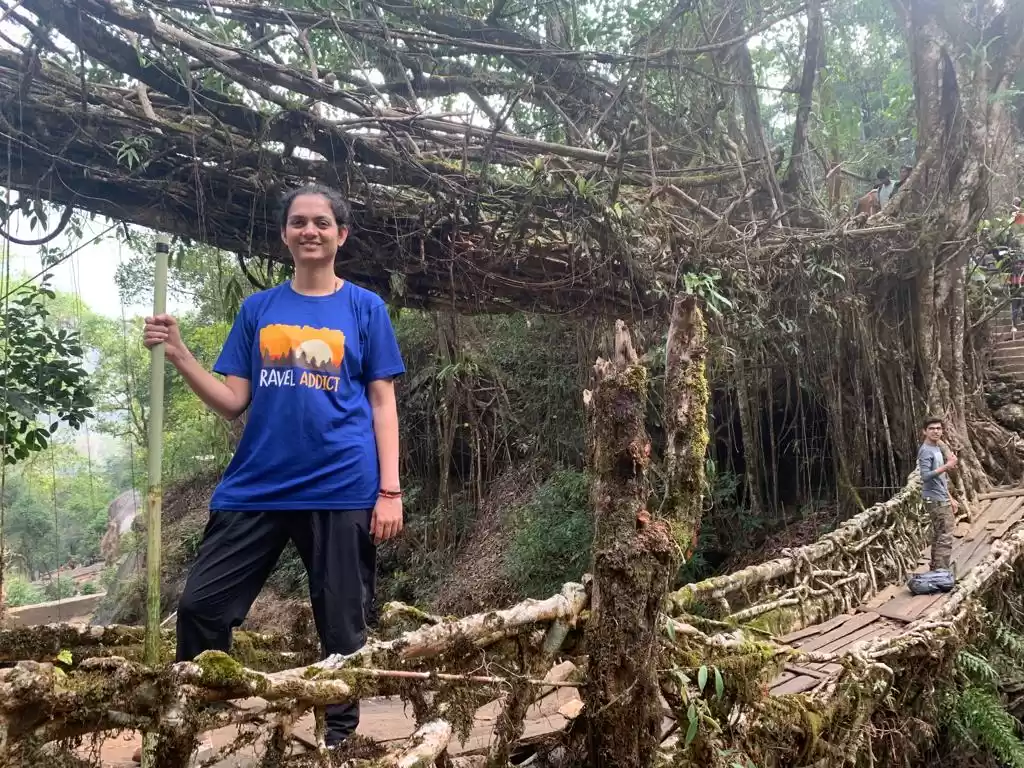







15 Apr'16 - The journey starts
The contrast in the shades outside the 6E813 Mumbai-Guwahati flight window grabbed our attention. The sun had done his work for the day and was descending. Watching the sunset, from an altitude of thousands of feet was breathtaking. The varying reddish orange colors between the blue sky above and dark clouds beneath was a pleasant view. We reached the hotel in Guwahati at 9 PM. Next day, we had planned to explore Guwahati and to reach Shillong by evening.
16 Apr'16 - In the midst of Tantricism and clouds
After having breakfast, we checked out of the hotel. Joydeb, our driver for the week was waiting in the lobby. He was from Assam and had charming mannerisms. Our first destination was the famous Kamakhya temple in Guwahati, the center of Tantricism. The landscape leading to the temple was very beautiful. Cruising at lower speeds up the greenery hills and the hairpin bends provided a majestic top view of Guwahati.
Kamrup Kamakhya temple, situated in the Nilachal hills was rebuilt in the 16th century and is dedicated to Goddess Kamakhya, the Hindu Tantric goddess of desire. Legend says that while Lord Shiva was carrying the corpse of his wife Sati, her womb fell to the ground at the spot where the temple now stands. The red colored saris of the lady devotees, the red attire of the priests and sadhus, and the sindoor stained sculptures gave a red hue to the whole premises. The temple is based on the Ahom style architecture. Kamakhya temple, well known for poojas against black magic has many Tantrik sacrifice places in the temple surroundings. The dark interior of the temples and sacrifice places, the red hue everywhere, the smoke arising from the homakundas, the poojas against black magic and the stories behind the temple mull the visitors into a mysterious experience. We spent about 2 hrs. there.
We had plans to visit a couple of more places in Guwahati, including the ancient Umadevi temple situated in Peacock island in the Brahmaputra river. Heavy rains toppled our plans for the day and we headed towards Shillong. We decided to visit these places on our return. It was the start of monsoon in the North East.
The serene landscape and the climate en-route Shillong was very lovely. After 30 minutes of our journey, we crossed the Assam-Meghalaya border and we started ascending several hills and heavy fog limited our visibility. The weather was very cool and the experience of cruising through the fog reminded us of the drives we had in Munnar and Vagamon in Kerala. Both sides of the road were covered in greenery and the clouds were coming down to kiss the hills. We got the first experience of the "Abode of the Clouds".
While we were having lunch, heavy rains started. We continued our journey. On both sides of the road, we found beautiful lilac flowered trees. Rains stopped and the pleasant sunshine and dense forests made us appreciate the beauty of the terrain. Around 2 PM, we reached Umiam lake. It is known for its beautiful landscape surrounded by hills and trees. We engaged in some water sports and spent more than an hour there. By 4:30, we reached Shillong, the capital of Meghalaya.
We went for an evening walk in the Police Bazaar and had lots of blackberries and raspberries and a kind of sour tasting green colored berry. Later, at 9 PM, we had some delicious local Khasi food for dinner. Next day, we had planned to roam in and around Shillong, the Scotland of the East and have to start at 9 AM.
17 Apr'16 - In and around Shillong
After breakfast, we headed towards Shillong peak. The curveous roads and the pine forests added to the serene landscape. This area is under Airforce and we had to take car pass and within few minutes, we were on top of Shillong. The view from the peak made us realize how big Shillong is. We continued our journey to Elephant water falls. The British had changed the name of the falls from "Ka kshaid lai pateng khohsiew" meaning three stepped waterfalls to Elephant falls as an adjacent huge rock resembled an elephant. This rock was destroyed in the 1897 earthquake. There are 3 falls here having unique views. Since the other areas of interest were in Shillong city, we drove back to the city for lunch and to spend the remaining day. After lunch, we spent an hour boating in Ward's Lake and then visited the Laitumkhrah Cathedral. This church seems the biggest one in Shillong. Prayers was going on then.
Our last destination for the day was the Lady Hydari park. Many varieties of beautiful flowers and plants and the silence over there were very relaxing. There is a mini zoo also there where one can watch owls, porcupines, deer, various types of birds etc. There were 3 Himalayan beers and could be seen so closely that one would feel like touching them. The cages were so small and felt that it would have been better to release them to their natural habitats.
We reached the hotel by 5 PM. Had lots of berries and later had awesome food for dinner.
18 Apr'16 - A travel to experience the rain
The plan for the day was a visit to the World's wettest place, Cherrapunjee. We started at 8 AM from Shillong. We took the left turn from the Elephant falls junction. Suddenly the landscape became more picturesque. The clouds enveloped the hills on both sides of the road and started embracing our path. It was a marvelous experience. We felt trapped inside the clouds and our car cruised slowly. No other name suits Meghalaya well. It was drizzling also in between.
The bends and turns on the road and the blanket of fog around us made our travel memorable. We stopped at a couple of places and took some photographs. The Wah Kaba falls on the way was not at all visible. We could hear the sound of the falls from the nearby valley. The hazy sight of the slow moving trucks cutting through the heavy fog was very beautiful. Many kids in their uniforms were on their way to schools. Saw many people travel by hanging to the rear of the buses. The climate became more and more hazy. It was drizzling continuously.
We reached Cherrapunjee hotel by 11 AM. The weather and the greenery around was so tempting that we started exploring the areas of interest there. We reached Motrop, around 10 kms drive from our stay. Motrop is outside Cherapunjee village. The weather became clearer. In the valley, we could see a giant conical rock in the shape of Shivlinga. Beneath we could see Bangladesh and in contrast to where we stood, it was a plain area. The water flowing from the East Khasi hills flows to Bangladesh. The drizzling rains and the forests surrounding the area and the water bodies gave a complete feeling of the wetness in Cherrapunjee. On the way back from Mortop, we visited Thangkharang park. From the view point, we could see many waterfalls eventually flowing into Bangladesh. This point also gave a beautiful glimpse of the valley, although it was covered by fog.
Our next destination was Mawsmai caves on top of a small hill. This is the only limestone cave in Meghalaya that's lit enough to explore the inside. We went inside the caves. Even though the entrance was somewhat big, some of the chambers inside were very small and not easy to explore. This magnificent wonder is formed by natural abrasion and underground water. The contrast between the dark grey and white colored rock protrusions magnified the cave's beauty. We went further inside. The uneven floor was covered with cold water and deep pools of water could be seen at many places. There are various paths leading to different chambers and definitely one would lose track of where he is going. The cave and its chambers looked like a mirror maze.
On the way back, we couldn't see Seven sisters waterfalls due to the heavy fog in the valley. After lunch, at 3 PM, the visibility was better. Again we went to the Seven sisters falls and could see three silver streams through the heavy fog. There was a small river following nearby and we spent some time there. It was around 4:30PM and darkness embraced the valley. We were back in hotel by 5 PM. It was drizzling continuously. We had garam pakoda and chai. We could see men fishing in the nearby river.
In the evening, heavy rains started accompanied by lightning and thunderstorms. We felt that time had come to a standstill. We had dinner by 8 PM. The electric bulbs started playing hide and seek. Heavy rains continued. We listened to some slow music. After some time, switched off the music and listened to the jugalbandhi created by the lashing rains, thunderstorms and wind. The gurgling river served as the background score. The same continued throughout the night. Read a couple of pages of "Bharat Yatra" and slowly slipped into sleep. Woke up at 4 AM and watched the nature's visual and musical performance. We really experienced what Cherrapunjee is up to.
19 Apr'16 - Through the cleanest streets and the border
Mawlynnong became famous after it has been certified as Asia's cleanest village by the travel magazine, Discover India and the border village; Dawki is famous for its green-bluish waters. These two places were our interests for the day. Rains had stopped. But, on our way to Mawlynnong, heavy fog slowed down our travel. Most of the time, our car was cruising in the second gear. We took the right turn at Laitlyngkot. The narrow road and the sudden rains and the clear surroundings made our drive a pleasant one. It was a single line road covered by greenery on both sides. We reached Nongthymmai by 11 AM. After climbing up and down the tree top view point, we went 300 steps down to see the living root bridge. The river flowing beneath the root bridge and the huge rocks that splashed its flow created a fantastic view. The root bridge is must visit if you are visiting Mawlynnong.
We reached Mawlynnong village situated in the East Khasi hills district of Maghalaya. There are about 100 families in this village. The village premises and the small restaurants were very clean and beautiful. After lunch, we walked along the concrete pavements watching the beautiful small houses built on top of wooden stilts. The vast variety of flowering plants and the butterflies, squirrels and the chirping of birds made us think about the simplicity of nature. There were few tourists and the area was very silent. A river was flowing nearby. Making use of bamboo dustbins, no littering in the surroundings etc. made this village the cleanest. The experience in this village made us think that all villages, towns and cities can be made clean if all of us follow the villagers of Mawlynnong. We could see many women working in the streets, shops and restaurants. Meghalaya has matrilineal system in which property names and wealth pass from mother to daughter rather than father to son.
We took the road to Dawki along the India-Bangladesh border. On our way, the Bophill waterfall was in its fierce form. The view of this unexplored wild beautiful waterfall from the bridge was terrific. The huge rocks made its fall zigzag. The heavy rains along the border might have made the falls so harsh. Very rarely we can see a waterfall turns into a river of a neighborhood country, into the Sylhet Borders of Bangladesh. There were more waterfalls on the way to Dawki, but the Bop hill falls was outstanding. Tried long exposure shots of the falls and it came pretty good.
We reached Dawki around 4 PM. The Umngot river had turned muddy and the flow was very strong. Usually, the water is very clear and one could see the bottom even from the beautiful suspension bridge built by the British. Even the shadow of the boats could be seen on the bottom of the river. Unfortunately, we missed that sight and the boating. Joydeb took us to the India Bangladesh border, named Tamabil, 2 kms from Umngot river. Many coal carrying trucks were waiting for their turn to cross the border, one of the few road border crossings between India and Bangladesh. An officer in the Indian Customs office next to the border allowed us to go till the boundary mark, a flat headed pyramid on which the number, 1275 is carved out. Welcome to Bangladesh and some road sign boards was erected in the border. I stepped a bit ahead of the boundary mark and the same officer came behind me. In short, I stepped onto the Bangladesh soil and Indians was not supposed to do that without valid documents. He told the 1275 pyramid was situated half on Indian soil and the other half on Bangladesh. We shared some pleasantries. We could see Bangladesh Customs office on the other side. Dhaka was 300 kms from there. Took some snaps and started our return journey to Shillong. Heavy rains and fog made driving difficult, but had really enjoyable experience. The sunset over the cloudy hills was very beautiful. We reached Shillong in the evening.
20 Apr'16 - Shillong to Kaziranga
On our way to Kaziranga national park, a World Heritage site, we saw lots of cows grazing on vast green lands. Partly cloudy, sometimes heavy fog, sometimes raining, sometimes sunny weather and the beautiful landscape on both sides of the road made the travel memorable. The roads were in good condition and the coconut and arecanut trees on both sides resembled Kerala. Kaziranga is 280 kms from Shillong. Nearing Kaziranga, from the national highway, we could see many one horned rhinoceroses in the nearby grass fields. Some wild boars and deers was also grazing nearby. We spotted some beautiful egrets also. Also spotted a mother rhinoceros and its calf grazing on the fields. We reached our resort at 3:30 PM. It was like an eco-park with lots of trees surrounded by tea gardens. The chirping of the birds and the silence over there was very relaxing. Went for a walk around the resort and watched the birds returning to their nests. By 5 PM, darkness crept in. We had opted a tent to stay. No television, no internet, some music we played and had hot tea. The evening passed very slowly.
We had dinner at 8 PM. It started raining heavily. At 4:30 AM the next day, we had to be ready for the elephant safari. We hoped of no rains in the morning.
It's 9:30 PM now. Good night!
21 April'16 - In search of the one horned endangered ones
We got up before 4 AM. It was raining heavily the whole night. It was a 20 minute drive from resort to the Kaziranga Western gate, where elephant safaris commence. Watching the habitats of Kaziranga while enjoying the elephant ride was a memorable experience. Rains had stopped by then. We went very near to wild elephants and rhinoceroses. Saw some of them half immersed in muddy ponds. We could see lots of wild boars, deers, wild buffaloes and rhinoceroses grazing in the vast grasslands on the other side of the lake. A rhinocerose and her calf were grazing nearby and our elephant went very near to them and the calf became afraid and separated from the mother. His attempt to go near his mother in spite of the elephant blocking his way was quite interesting. We saw many varieties of storks also. The safari was for one hour and we reached the resort by 7 and it started raining heavily. We had the Central range jeep safari at 8 AM.
During the open jeep safari, we saw many rhinoceroses, wild elephants, various species of beautiful birds, storks, owls, jungle fowls etc. A wild elephant came across from the elephant grass, somewhat 20 meters away from us, blocking our way, stared at us for a few moments and then crossed the road. For a moment, we felt that he would charge on us. It was one of the most beautiful sights and a fearful one. On our way back, we saw rhinoceroses plunged in the lake looking us with atmost curiosity. The weather was also like it could rain at any time, but didn't. We were very happy as we saw many varieties of species in the backdrop of beautiful surroundings. Reached our resort, had lunch and had planned for another jeep safari in the Western range of the National park.
Our jeep slowly cruised on the rough roads inside the Kaziranga National park. We saw many wild buffaloes and needless to say, we saw many wild elephants, vultures, jungle fowls and rhinoceroses. A mother and her child rhinoceros crossing the river was a beautiful sight. Kaziranga is home to 2401 one horned rhinoceroses as per 2015 census and two thirds of the world's total population of this species resides here. Amidst the tight security, poaching of rhinoceroses still happens. Seven rhinoceroses were killed in the last four months. Their horn is of high medicinal value and a pair of horns fetches up to half a million USD in the International market.
We enjoyed the rides and safaris and learnt many things about rhinoceroses from Shankar, our jeep driver. He has a good knowledge about the flora and fauna of Kaziranga. On our way back, the 20 km open jeep safari from the Western gate to our resort experiencing the drizzle and cold wind is memorable.
During all these days, we were hitting the bed at 10 PM or so and getting up very early. In the North East, during this time, both sunset and sunrise happens very early. In the last 7 days, we had varied memories and experience, from the mysterious Kamakhya temple to the bustling Shillong streets to the chilling Cherrapunjee to the cleanest village in Asia to the India-Bangladesh border in Dawki to the travel to Kaziranga and exploring its wildlife and flora and fauna - The eternal journey through the wonderlands of Meghalaya and Assam.....
The next day, we started our return to Mumbai via Guwahati and Kolkatta.

